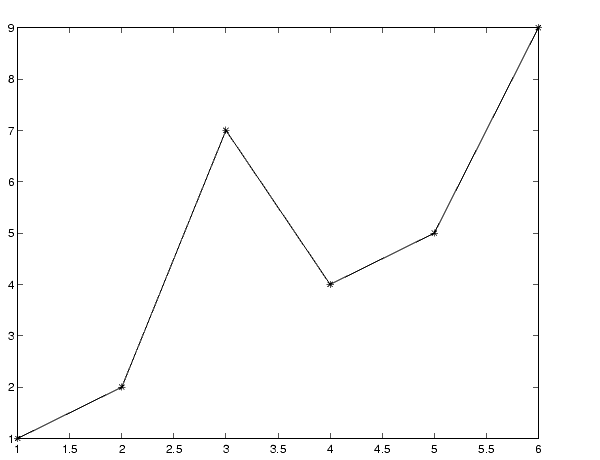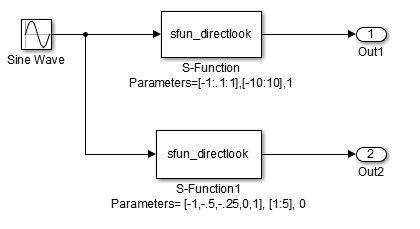Write Fully Inlined S-Functions with mdlRTW Routine
You can inline more complex S-functions by using the S-function mdlRTW routine. The mdlRTW routine
provides the code generation process with more information about how the S-function is
to be inlined by creating a parameter record of a non-tunable parameter for use with a
TLC file. The mdlRTW routine places information in the
model.rtwmdlRTW function is described in the text file
matlabroot/toolbox/simulink/blocks/src/sfuntmpl_doc.c
To use the mdlRTW function, take steps to create a direct-index
lookup S-function. Lookup tables are collections of ordered data points of a function.
Typically, these tables use some interpolation scheme to approximate values of the
associated function between known data points. To incorporate the example lookup table
algorithm into a Simulink® model, the first step is to write an S-function that executes the
algorithm in mdlOutputs. To produce the most efficient code, the
next step is to create a corresponding TLC file to eliminate computational overhead and
improve the speed of the lookup computations.
The Simulink product provides support for general-purpose lookup 1-D, 2-D, and n-D
algorithms. You can use these algorithms as they are or create a custom lookup table
S-function to fit your requirements. You can create a 1-D lookup S-function,
sfun_directlook.c, and its corresponding inlined
sfun_directlook.tlc file (see Target Language Compiler for more
details). You can:
Error check of S-function parameters.
Cache information for the S-function that does not change during model execution.
Use the
mdlRTWfunction to customize the code generator to produce the optimal code for a given set of block parameters.Create a
TLCfile for an S-function that either fully inlines the lookup table code or calls a wrapper function for the lookup table algorithm.
S-Function RTWdata
RTWdata is a property of blocks, which can be used by the
Target Language Compiler when inlining an S-function. RTWdata is
a structure of character vectors that you can attach to a block.
RTWdata is saved with the model and placed in the
model.rtw
mydata.field1 = 'information for field1'; mydata.field2 = 'information for field2'; set_param(gcb,'RTWdata',mydata) get_param(gcb,'RTWdata')
produces this result:
ans =
field1: 'information for field1'
field2: 'information for field2'The information for the associated S-Function block inside the
model.rtw
Block {
Type "S-Function"
RTWdata {
field1 "information for field1"
field2 "information for field2"
}Note
RTWdata is saved in the model file for S-functions that are
not linked to a library. However, RTWdata is not persistent for S-Function blocks that are linked
to a library.
Direct-Index Lookup Table Algorithm
The 1-D lookup table block provided in the Simulink library uses interpolation or extrapolation when computing outputs. In this example, you create a lookup table that directly indexes the output vector (y-data vector) based on the current input (x-data) point.
This direct 1-D lookup example computes an approximate solution p(x)to a partially known function f(x) at x=x0, given data point pairs (x,y) in the form of an x-data vector and a y-data vector. For a given data pair (for example, the i'th pair), y_i = f(x_i). It is assumed that the x-data values are monotonically increasing. If x0 is outside the range of the x-data vector, the first or last point is returned.
The parameters to the S-function are:
XData, YData, XEvenlySpaced
XData and YData are double vectors of equal
length representing the values of the unknown function.
XDataEvenlySpaced is a scalar, 0.0 for
false and 1.0 for true. If the XData vector is
evenly spaced, XDataEvenlySpaced is 1.0 and
more efficient code is generated.
The graph shows how the parameters XData=[1:6]and
YData=[1,2,7,4,5,9] are handled. For example, if the input
(x-value) to the S-Function block is 3, the output
(y-value) is 7.

Direct-Index Lookup Table Example
Improve the lookup table by inlining a direct-index S-function with a TLC file. This direct-index lookup table S-function does not require a TLC file. The example uses a TLC file for the direct-index lookup table S-function to reduce the code size and increase efficiency of the generated code.
Implementation of the direct-index algorithm with an inlined TLC file requires the
S-function main module, sfun_directlook.c and a corresponding lookup_index.c module. The lookup_index.c
module contains the GetDirectLookupIndex function that is used
to locate the index in the XData for the current
x input value when the XData is unevenly
spaced. The GetDirectLookupIndex routine is called from the
S-function and the generated code. The example uses the wrapper concept for sharing
C/C++ code between Simulink MEX-files and the generated code.
If the XData is evenly spaced, then both the S-function main
module and the generated code contain the lookup algorithm to compute the
y-value of a given x-value because the
algorithm is short.
The inlined TLC file is sfun_directlook.tlc, which is used to either perform a
wrapper call or embed the optimal C/C++ code for the S-function. (See the example in
mdlRTW Usage).
Error Handling
In sfun_directlook.tlc, the
mdlCheckParameters routine verifies that:
The new parameter settings are valid.
XDataandYDataare vectors of the same length containing real, finite numbers.XDataEvenlySpacedis a scalar.The
XDatavector is a monotonically increasing vector and evenly spaced.
The mdlInitializeSizes function explicitly calls
mdlCheckParameters after it verifies the number of
parameters passed to the S-function. After the Simulink engine calls mdlInitializeSizes, it then calls
mdlCheckParameters whenever you change the parameters or
reevaluate them.
User Data Caching
In sfun_directlook.tlc, the mdlStart
routine shows how to cache information that does not change during the simulation or
while the generated code is executing. The example caches the value of the
XDataEvenlySpaced parameter in UserData, a
field of the SimStruct. The following line in
mdlInitializeSizes instructs the Simulink engine to disallow changes to
XDataEvenlySpaced.
ssSetSFcnParamTunable(S, iParam, SS_PRM_NOT_TUNABLE);
During execution, mdlOutputs accesses the value of
XDataEvenlySpaced from UserData rather
than calling the mxGetPr
MATLAB API function.
mdlRTW Usage
The code generator calls the mdlRTW routine while generating
the model.rtwmodel.rtw
The example adds parameter settings to the
model.rtwXDataEvenlySpaced S-function parameter cannot change during
execution (ssSetSFcnParamTunable was specified as false
(0) for it in mdlInitializeSizes). The
parameter setting (XSpacing) uses the function
ssWriteRTWParamSettings.
Because xData and yData are registered as
run-time parameters in mdlSetWorkWidths, the code generator
writes to the model.rtw
Before examining the S-function and the inlined TLC file, consider the generated code for this model.

The model uses evenly spaced XData in the top S-Function block
and unevenly spaced XData in the bottom S-Function block. When
creating this model, specify the following commands for each S-Function
block.
set_param('sfun_directlook_ex/S-Function','SFunctionModules','lookup_index') set_param('sfun_directlook_ex/S-Function1','SFunctionModules','lookup_index')
The build process uses the module lookup_index.c when creating
the executable.
When generating code for this model, the code generator uses the S-function
mdlRTW method to generate a
model.rtwEvenlySpaced for the XSpacing parameter
for the top S-Function block and the value UnEvenlySpaced for the
XSpacing parameter for the bottom S-Function block. The
TLC-file uses the value of XSpacing to determine what algorithm
to include in the generated code. The generated code contains the lookup algorithm
when the XData is evenly spaced, but calls the
GetDirectLookupIndex routine when the
XData is unevenly spaced. The generated
model.cmodel.cpp
/*
* sfun_directlook_ex.c
*
* Code generation for Simulink model
* "sfun_directlook_ex.slx".
*
...
*/
#include "sfun_directlook_ex.h"
#include "sfun_directlook_ex_private.h"
/* External outputs (root outports fed by signals with auto storage) */
ExtY_sfun_directlook_ex_T sfun_directlook_ex_Y;
/* Real-time model */
RT_MODEL_sfun_directlook_ex_T sfun_directlook_ex_M_;
RT_MODEL_sfun_directlook_ex_T *const sfun_directlook_ex_M =
&sfun_directlook_ex_M_;
/* Model output function */
void sfun_directlook_ex_output(void)
{
/* local block i/o variables */
real_T rtb_SFunction;
real_T rtb_SFunction1;
/* Sin: '<Root>/Sine Wave' */
rtb_SFunction1 = sin(sfun_directlook_ex_M->Timing.t[0]);
/* Code that is inlined for the top S-function block in the
* sfun_directlook_ex model
*/
/* S-Function (sfun_directlook): '<Root>/S-Function' */
{
const real_T *xData = sfun_directlook_ex_ConstP.SFunction_XData;
const real_T *yData = sfun_directlook_ex_ConstP.SFunction_YData;
real_T spacing = xData[1] - xData[0];
if (rtb_SFunction1 <= xData[0] ) {
rtb_SFunction = yData[0];
} else if (rtb_SFunction1 >= yData[20] ) {
rtb_SFunction = yData[20];
} else {
int_T idx = (int_T)( ( rtb_SFunction1 - xData[0] ) / spacing );
rtb_SFunction = yData[idx];
}
}
/* Outport: '<Root>/Out1' */
sfun_directlook_ex_Y.Out1 = rtb_SFunction;
/* Code that is inlined for the bottom S-function block in the
* sfun_directlook_ex model
*/
/* S-Function (sfun_directlook): '<Root>/S-Function1' */
{
const real_T *xData = sfun_directlook_ex_ConstP.SFunction1_XData;
const real_T *yData = sfun_directlook_ex_ConstP.SFunction1_YData;
int_T idx;
idx = GetDirectLookupIndex(xData, 5, rtb_SFunction1);
rtb_SFunction1 = yData[idx];
}
/* Outport: '<Root>/Out2' */
sfun_directlook_ex_Y.Out2 = rtb_SFunction1;
}
/* Model update function */
void sfun_directlook_ex_update(void)
{
/* signal main to stop simulation */
{ /* Sample time: [0.0s, 0.0s] */
if ((rtmGetTFinal(sfun_directlook_ex_M)!=-1) &&
!((rtmGetTFinal(sfun_directlook_ex_M)-sfun_directlook_ex_M->Timing.t[0])
> sfun_directlook_ex_M->Timing.t[0] * (DBL_EPSILON))) {
rtmSetErrorStatus(sfun_directlook_ex_M, "Simulation finished");
}
}
/* Update absolute time for base rate */
/* The "clockTick0" counts the number of times the code of this task has
* been executed. The absolute time is the multiplication of "clockTick0"
* and "Timing.stepSize0". Size of "clockTick0" ensures timer will not
* overflow during the application lifespan selected.
* Timer of this task consists of two 32 bit unsigned integers.
* The two integers represent the low bits Timing.clockTick0 and the high bits
* Timing.clockTickH0. When the low bit overflows to 0, the high bits increment.
*/
if (!(++sfun_directlook_ex_M->Timing.clockTick0)) {
++sfun_directlook_ex_M->Timing.clockTickH0;
}
sfun_directlook_ex_M->Timing.t[0] = sfun_directlook_ex_M->Timing.clockTick0 *
sfun_directlook_ex_M->Timing.stepSize0 +
sfun_directlook_ex_M->Timing.clockTickH0 *
sfun_directlook_ex_M->Timing.stepSize0 * 4294967296.0;
}
...